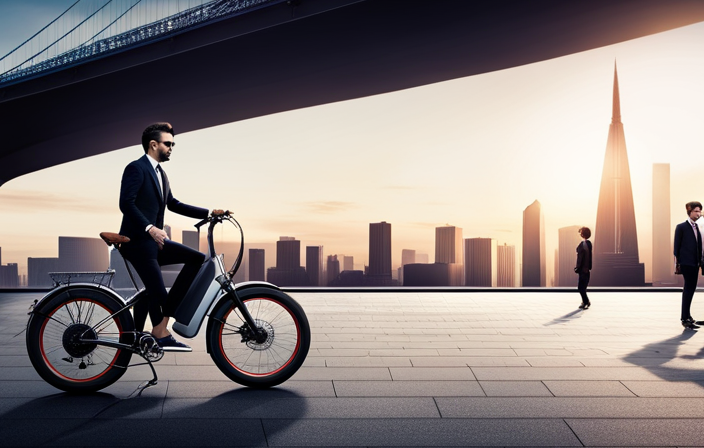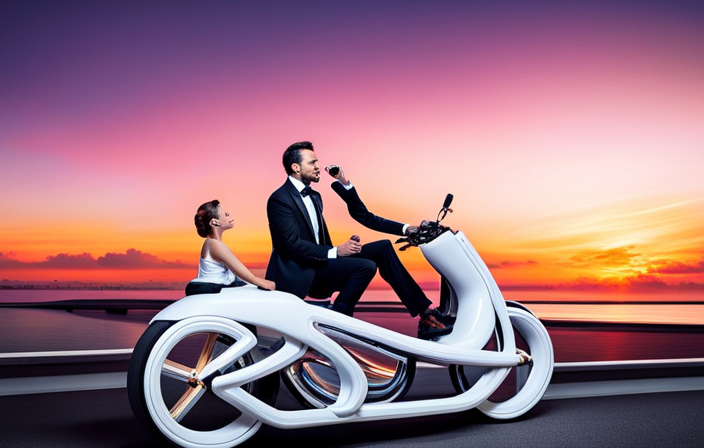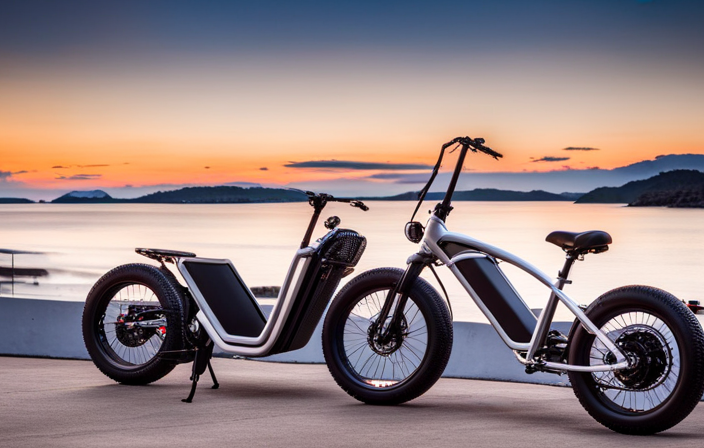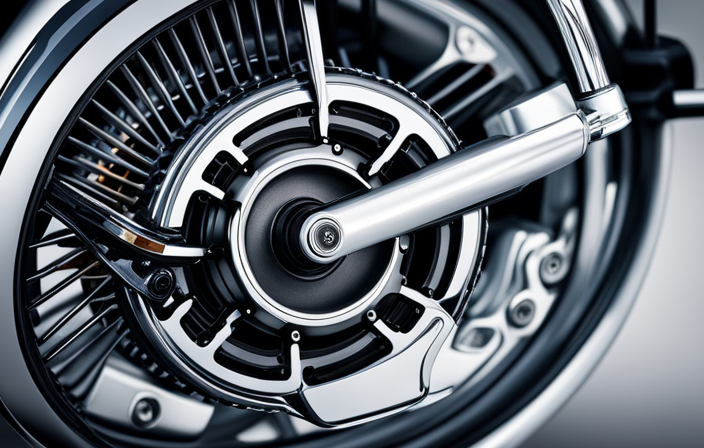You might be wondering, ‘How long does it take to charge an electric bike?’ Well, I’m here to tell you that charging an electric bike is a quick and efficient process.
In this article, we will explore the factors that affect charging time, average charging times for electric bikes, and tips on how to extend battery life.
Additionally, we will address common charging issues and solutions, as well as discuss the future developments in electric bike charging technology.
So, let’s dive in and demystify the charging process for electric bikes!
Key Takeaways
- Electric bike batteries can be charged in around 4-6 hours on average.
- Fast charging options can reduce the charging time to 1-2 hours.
- Factors such as battery capacity, charging speed, and infrastructure availability can affect the charging time.
- Following battery maintenance best practices and using high-quality chargers can optimize charging efficiency and preserve battery lifespan.
Understanding Electric Bike Batteries
Understanding electric bike batteries is crucial for knowing how long it takes to charge an electric bike. Electric bike batteries play a vital role in determining the charging time. To extend battery range and maximize performance, it is important to follow best practices for battery maintenance. These include storing the battery at an optimal temperature, avoiding overcharging or completely draining the battery, and using the correct charging equipment. Regularly cleaning the battery terminals and ensuring a secure connection also contribute to efficient charging. Additionally, using a high-quality charger specifically designed for electric bike batteries is essential.
By understanding the intricacies of electric bike batteries and implementing proper maintenance techniques, you can optimize the charging time and overall longevity of your battery. Now, let’s explore the factors that affect charging time.
Factors Affecting Charging Time
To determine the time it takes to recharge your e-bike, consider various factors. The charging time of an electric bike can vary depending on several key factors affecting charging time. These factors include:
- Battery capacity: The higher the capacity of the battery, the longer it will take to charge.
- Current charging level: The closer the battery is to being fully depleted, the longer it will take to charge.
- Charger output: The power output of the charger can affect charging time, with higher output chargers generally charging faster.
To ensure the best charging practices, it’s recommended to use the charger provided by the manufacturer and follow their instructions. Additionally, it’s important to avoid overcharging the battery, as this can reduce its overall lifespan.
Considering these factors affecting charging time and following the best charging practices, you can optimize the charging time of your e-bike.
Now, let’s move on to the next section about the average charging time for electric bikes.
Average Charging Time for Electric Bikes
On average, the charging time for electric bikes can vary depending on several factors. However, the standard charging time for most electric bikes is around 4 to 6 hours.
For those who are looking for faster charging options, there are now fast charging options available that can significantly reduce the charging time to as little as 1 to 2 hours.
Standard Charging Time
The standard charging time for your electric bike is typically around 4-6 hours. This may vary depending on the battery capacity and charging speed of your specific electric bike model.
To give you a better understanding of the charging process, here are three key considerations:
-
Battery Capacity: The larger the battery capacity of your electric bike, the longer it will take to charge. Higher capacity batteries require more time to reach a full charge compared to smaller ones.
-
Charging Speed: The charging speed also plays a significant role in determining the charging time. Electric bikes equipped with fast charging technology can charge at a quicker rate, reducing the overall charging time.
-
Charging Infrastructure: The availability and quality of charging infrastructure can affect the charging time. Having access to high-power charging stations can significantly decrease the time it takes to charge your electric bike.
Understanding these factors can help you gauge the standard charging time for your electric bike. However, if you’re looking for faster charging options, there are alternative methods available.
Fast Charging Options
One option for faster charging is using a high-power charging station. These stations are equipped with advanced technology that allows for a quicker charging time compared to standard charging methods. The benefits of fast charging are numerous. Firstly, it saves time and allows you to quickly get back on the road. Secondly, it is more convenient as you don’t have to wait for hours for your electric bike to charge. Additionally, fast charging can be beneficial when you are on the go and need a quick boost of power. It is important to note that fast charging options may vary depending on the model and brand of your electric bike. Now, let’s explore how to extend the battery life of your electric bike without compromising its performance.
How to Extend Battery Life
To extend the battery life of your electric bike, it’s important to follow proper charging practices. Maximizing charging efficiency is crucial in prolonging the lifespan of your battery. Here are four key strategies to help you achieve this:
-
Avoid overcharging: Once your battery reaches its full capacity, unplug it immediately to prevent overcharging, which can degrade its performance over time.
-
Charge at the right temperature: Extreme temperatures can negatively affect battery health. Charge your electric bike indoors, away from harsh weather conditions, to maintain an optimal temperature range.
-
Use the correct charger: Always use the charger provided by the manufacturer, as using incompatible chargers can lead to inefficient charging and potential damage to your battery.
-
Avoid deep discharges: It’s best to recharge your battery before it completely drains. Frequent deep discharges can strain the battery and reduce its overall capacity.
By following these practices, you can extend the life of your electric bike’s battery.
Now, let’s move on to the next section, where we’ll discuss how to charge an electric bike at home.
Charging an Electric Bike at Home
You can easily charge your e-bike at home by following a few simple steps.
First, make sure you have a dedicated charging station or a wall outlet that is easily accessible.
Plug in the charger that came with your electric bike into the charging port located on the battery.
The charging speed will vary depending on the battery capacity and the charger’s output. It usually takes around 4 to 6 hours to fully charge an e-bike battery.
If you’re in a hurry, there are portable charging options available that can charge your battery faster. These options provide a higher output and can significantly reduce charging time.
Once your e-bike is fully charged, you can disconnect it from the charger and enjoy your ride.
Now, let’s explore how to charge an electric bike on the go without compromising your journey.
Charging an Electric Bike on the Go
When it comes to charging an electric bike on the go, there are several portable charging options available. These options allow you to charge your electric bike even when you’re away from home or don’t have access to a traditional charging station. One such option is a portable charger, which is a compact device that can be easily carried in a backpack or saddlebag. Another option is a solar charger, which harnesses the power of the sun to charge your electric bike. These portable charging options provide flexibility and convenience, allowing you to charge your electric bike wherever you are. In the next section, we will discuss some tips for efficient charging to make the most out of your charging time.
Tips for Efficient Charging
When it comes to efficient charging of an electric bike, there are a few key points to keep in mind.
First, charging overnight is a convenient and time-efficient option, allowing for a full charge by the time you wake up.
Additionally, charging during off-peak hours can help to reduce electricity costs and avoid strain on the power grid.
Lastly, utilizing smart charging features can optimize the charging process by automatically adjusting settings for maximum efficiency.
Charging Overnight
Charging an electric bike overnight typically takes several hours. It is a convenient and efficient way to ensure your bike is fully charged and ready for use the next day. Here are some reasons why charging overnight is a good idea:
-
Convenience: Charging overnight allows you to simply plug in your bike before going to bed, saving you time during the day.
-
Safety: Charging at home eliminates the risk of theft or damage that could occur when charging in public places.
-
Cost savings: Charging during off-peak hours can save you money on electricity costs.
-
Battery longevity: Overnight charging allows the battery to cool down after use, which can help extend its lifespan.
-
Eco-friendly: Charging overnight reduces the strain on the power grid during peak hours, contributing to a greener environment.
Now, let’s move on to the next section about charging during off-peak hours.
Charging During Off-Peak Hours
During off-peak hours, it is advisable to charge your e-bike to take advantage of lower electricity costs. By utilizing smart grid integration and charging your electric bike during off-peak hours, you can benefit from reduced electricity rates. This not only saves you money but also helps support the stability of the electrical grid. Off-peak electricity rates are typically lower due to lower demand, allowing you to charge your e-bike at a more cost-effective rate. To illustrate the potential savings, consider the following table:
| Time of Charging | Cost per kWh |
|---|---|
| Off-Peak Hours | $0.10 |
| Peak Hours | $0.20 |
By charging during off-peak hours, you can cut your charging costs in half. This smart charging approach optimizes the use of electricity and promotes sustainability. Utilizing smart charging features further enhances the efficiency of your e-bike charging process. [Transition into the subsequent section about ‘using smart charging features’].
Using Smart Charging Features
Smart charging features can greatly enhance the efficiency and convenience of charging your e-bike. These features offer a range of benefits, such as optimizing charging efficiency and reducing charging times. By utilizing smart charging capabilities, you can ensure that your electric bike is charged in the most efficient way possible, saving you time and energy.
These features may include advanced charging algorithms that monitor the battery’s state of charge and adjust the charging rate accordingly. Some smart chargers even have the ability to communicate with the electric bike’s battery management system, allowing for precise control and optimization of the charging process.
With these smart charging features, you can make the most out of your charging time and get back on the road faster.
Transitioning into the next section, let’s now explore the charging time for different electric bike models.
Charging Time for Different Electric Bike Models
The charging time for different electric bike models can vary. Several factors influence the charging time, including the battery capacity and the charging method used. A higher battery capacity usually means a longer charging time. For example, a bike with a 500Wh battery may take around 3-4 hours to charge fully, while a bike with a 1000Wh battery could take 6-8 hours. Additionally, the charging method can also impact the time it takes to charge an electric bike. Using a smart charger with fast-charging capabilities can significantly reduce the charging time. It’s important to note that these times are approximate and can vary depending on the specific bike model and charger used. In the next section, we will explore the possibility of charging an electric bike with solar power.
Charging an Electric Bike with Solar Power
You can utilize solar power to charge your electric bike. When it comes to charging efficiency, portable solar panels are a great option. These panels are designed to convert sunlight into electricity, which can then be used to charge your electric bike’s battery.
The charging efficiency of portable solar panels can vary depending on factors such as the size and quality of the panels, as well as the amount of sunlight available. It is important to choose a high-quality panel that is designed specifically for charging electric bike batteries to ensure optimal performance.
Once you have your portable solar panel set up, you can easily harness the power of the sun to charge your electric bike wherever you go. This environmentally-friendly charging method is not only convenient but also helps reduce your carbon footprint.
Moving on to charging etiquette and safety precautions…
Charging Etiquette and Safety Precautions
When it comes to charging etiquette and safety precautions, there are a few key points to keep in mind.
First, it is important to be considerate and share charging stations with others, especially if there is limited availability.
Second, it is crucial to avoid overheating the charging equipment by not exceeding the recommended charging times or using incompatible chargers.
Lastly, it is essential to take fire hazards seriously by keeping the charging area clear of flammable materials and regularly inspecting the charging equipment for any signs of damage or malfunction.
Sharing Charging Stations
Sharing charging stations can reduce the time it takes to charge an electric bike. By utilizing a shared charging infrastructure, multiple bikes can be charged simultaneously, maximizing the efficiency of the charging process. Here are three benefits of community charging:
-
Convenience: With shared charging stations, you don’t have to worry about finding an available outlet or waiting in line to charge your bike. The stations are strategically placed in easily accessible locations, making it convenient for everyone.
-
Faster Charging: When multiple bikes are charging at the same time, the charging power is distributed evenly, allowing each bike to charge faster. This means less time waiting and more time riding.
-
Cost Efficiency: Sharing charging stations reduces the need for individual charging setups. This not only saves space but also helps in cost-sharing, making it more affordable for everyone.
By embracing shared charging infrastructure, we can charge our electric bikes faster and more efficiently, ensuring a seamless riding experience.
Now, let’s explore how to avoid overheating and fire hazards while charging.
Avoiding Overheating and Fire Hazards
To prevent overheating and fire hazards, it is important to follow proper charging protocols for electric bikes. Wireless charging benefits can be a game-changer for convenience, but it is crucial to ensure that the charging process is monitored closely to prevent battery degradation. Here is a table that highlights the do’s and don’ts of electric bike charging:
| Do’s | Don’ts | Recommendations |
|---|---|---|
| Use the charger provided by the manufacturer | Charge the battery unattended | Regularly check battery temperature |
| Charge in a well-ventilated area | Charge the battery on flammable surfaces | Avoid charging in extreme temperatures |
| Follow the recommended charging time | Overcharge the battery | Use a surge protector |
By adhering to these guidelines, you can ensure safe and efficient charging for your electric bike. Understanding battery indicators and monitoring is vital to maintaining a healthy battery life.
Understanding Battery Indicators and Monitoring
You can easily understand the battery indicators and monitor the charging process of your electric bike. It is essential for battery maintenance and ensuring a longer battery lifespan.
Here are four key aspects to consider when it comes to understanding battery indicators and monitoring:
-
Battery level indicator: This feature displays the current charge level of your electric bike’s battery, allowing you to know when it needs to be charged.
-
Charging progress indicator: This indicator shows the progress of the charging process, giving you an estimate of how much longer it will take to fully charge the battery.
-
Fault indicator: This indicator alerts you if there is a problem with the battery or the charging process, enabling you to take appropriate action.
-
Overcharging protection: Many electric bikes have built-in mechanisms to prevent overcharging, ensuring the battery does not get damaged.
Understanding battery indicators and monitoring is crucial for maintaining your electric bike’s battery and maximizing its lifespan. It also helps in identifying common charging issues and finding suitable solutions.
Common Charging Issues and Solutions
Experiencing common charging issues with your electric bike can be frustrating, but there are solutions available to help you resolve them effectively.
When it comes to charging issues, it’s important to diagnose the problem correctly. Start by checking the power source and making sure it’s functioning properly. If the power source is fine, examine the charging cable for any signs of damage. Sometimes, the issue can be as simple as a loose connection or a faulty cable.
Additionally, ensure that the battery contacts are clean and free from any dirt or corrosion. If all else fails, consult the user manual or contact the manufacturer for further troubleshooting techniques. By addressing these common charging issues, you can ensure a smooth and efficient charging process for your electric bike.
Transitioning into the subsequent section about charging times for electric bike accessories, it’s essential to understand how long it takes to charge different components.
Charging Times for Electric Bike Accessories
For charging electric bike accessories, it’s important to know the amount of time it typically takes. Here are the charging times for some common electric bike accessories:
-
Electric Bike Lights: The charging time for electric bike lights can vary depending on the model and battery capacity. On average, it takes around 2-4 hours to fully charge electric bike lights. It’s recommended to use the optimal charging voltage specified by the manufacturer to ensure efficient charging and maximize battery life.
-
Electric Bike Horns: Electric bike horns usually have smaller batteries compared to lights, so they require less charging time. It typically takes around 1-2 hours to fully charge electric bike horns.
-
Electric Bike Phone Mounts: Electric bike phone mounts often come with built-in power banks to charge your phone on the go. The charging time for these power banks can vary, but it usually takes around 3-5 hours to fully charge them.
-
Electric Bike Speakers: Similarly, electric bike speakers with built-in batteries can take around 3-5 hours to fully charge.
When it comes to charging an electric bike in extreme weather conditions, there are a few important considerations to keep in mind.
Charging an Electric Bike in Extreme Weather Conditions
When it comes to charging an electric bike in extreme weather conditions, there are a few important tips to keep in mind.
In cold weather, it is crucial to keep the battery warm to ensure efficient charging. This can be done by storing the bike indoors or using insulated covers.
In hot weather, it is important to avoid exposing the bike to direct sunlight and excessive heat, as this can damage the battery. Additionally, it is recommended to charge the bike in a shaded area or during cooler parts of the day to maintain optimal charging conditions.
Cold Weather Charging Tips
To charge your electric bike in cold weather, you’ll want to follow these tips:
-
Keep your battery warm: Cold weather can decrease the efficiency of your battery and reduce its overall capacity. To combat this, store your battery in a warm environment before charging. This will help maintain its performance and extend its lifespan.
-
Charge at room temperature: Avoid charging your electric bike in extremely cold temperatures. Instead, bring your bike indoors and charge it at room temperature. This will ensure a more efficient charging process and help prevent any damage to the battery.
-
Use a smart charger: Invest in a smart charger that is specifically designed for cold weather charging. These chargers have built-in features that optimize the charging process for lower temperatures, allowing for faster and more efficient charging.
By following these tips, you can ensure that your electric bike’s battery is well taken care of during cold weather conditions.
Now, let’s move on to the next section about hot weather charging tips.
Hot Weather Charging Tips
Hot weather can greatly affect the charging process of an electric bike’s battery. When charging in humid weather, it is crucial to ensure that the battery and charging equipment are kept in a cool and dry environment. Excess moisture can lead to corrosion and damage to the battery, reducing its overall lifespan.
Additionally, high temperatures can increase the internal resistance of the battery, resulting in slower charging times. It is recommended to avoid charging the electric bike in direct sunlight or in extremely hot conditions. Similarly, charging an electric bike in high altitudes can also impact the charging process. Due to the lower air density, the cooling effect is reduced, and the battery may heat up faster.
Taking these factors into consideration is essential for optimizing the charging process and maintaining the longevity of your electric bike’s battery. Looking ahead, future developments in electric bike charging technology will likely address these challenges and provide more efficient and reliable charging solutions.
Future Developments in Electric Bike Charging Technology
In the future, there are two key developments in electric bike charging technology that I find particularly exciting.
First, wireless charging is a game changer that eliminates the need for cumbersome cables and connectors. With this technology, all you need to do is place your electric bike on a charging pad, and it will start charging automatically.
Second, there are faster charging solutions being developed that can dramatically reduce the charging time of electric bikes. These advancements will allow riders to quickly recharge their bikes and get back on the road in no time.
Wireless Charging
Charging an electric bike wirelessly takes less time than using a traditional corded charger. With wireless charging technology, you can say goodbye to the hassle of plugging and unplugging cords. Here are some benefits of wireless charging:
- Convenience: Wireless charging allows you to simply place your electric bike on a charging pad, eliminating the need for messy cables.
- Efficiency: The charging pad transfers energy directly to the bike’s battery, resulting in a more efficient charging process.
- Durability: Wireless charging eliminates the wear and tear that can occur on charging ports over time.
However, there are also a few drawbacks to consider:
- Limited range: Wireless charging pads have a limited range, so you need to be in close proximity to the pad for charging.
- Slower charging speed: Although wireless charging is convenient, it may take slightly longer to fully charge your electric bike compared to corded chargers.
- Cost: Wireless charging technology can be more expensive to implement compared to traditional charging methods.
In the next section, we will explore faster charging solutions to further enhance the charging experience.
Faster Charging Solutions
Now let’s delve into the exciting realm of faster charging solutions for electric bikes.
With the ever-growing popularity of e-bikes, the need for quicker charging methods has become paramount. Fortunately, advancements in rapid charging technology have emerged, promising to revolutionize the charging experience.
These cutting-edge solutions aim to reduce the time it takes to juice up your electric bike, allowing you to hit the road faster than ever before. By utilizing innovative techniques and smart algorithms, these faster charging methods optimize the flow of electricity, ensuring efficient and speedy charging cycles.
Whether it’s through high-powered charging stations or advanced battery technologies, manufacturers are striving to provide e-bike owners with a seamless charging experience that minimizes downtime and maximizes ride time.
So, get ready to embrace the future of electric bike charging with these impressive faster charging solutions.
Frequently Asked Questions
Can I use a regular charger to charge my electric bike?
Yes, you can use a regular charger to charge your electric bike. However, it’s important to ensure that the charging port of your bike is compatible with the charger.
How often should I charge my electric bike’s battery?
I recommend charging my electric bike’s battery regularly to maintain its lifespan. The charging frequency depends on usage, but a general guideline is to charge it after every ride or at least once a week.
Can I charge my electric bike’s battery with a power bank?
Yes, you can charge your electric bike’s battery with a power bank. This alternative charging method allows you to charge while riding, providing convenience and flexibility for longer cycling trips.
Is it safe to charge my electric bike overnight?
Charging an electric bike overnight can pose potential fire hazards. It is recommended to avoid leaving it unattended for long periods. To extend the battery’s lifespan, follow optimal charging practices such as avoiding overcharging and extreme temperature conditions.
What should I do if my electric bike’s battery is not charging properly?
If my electric bike’s battery is not charging properly, I would first troubleshoot the issue by checking the charging cable, power source, and battery connections. Common battery charging issues can be caused by faulty components or a damaged battery.
Conclusion
In conclusion, the charging time for electric bikes can vary depending on multiple factors such as battery capacity, charger power, and usage patterns. On average, it takes around 3-6 hours to fully charge an electric bike.
However, by following maintenance tips and extending battery life, we can ensure longer ride times. Charging an electric bike at home is convenient and easy, but it is essential to address common charging issues promptly.
With advancements in technology, we can expect faster and more efficient charging solutions in the future, like a symphony of power for your electric steed.









